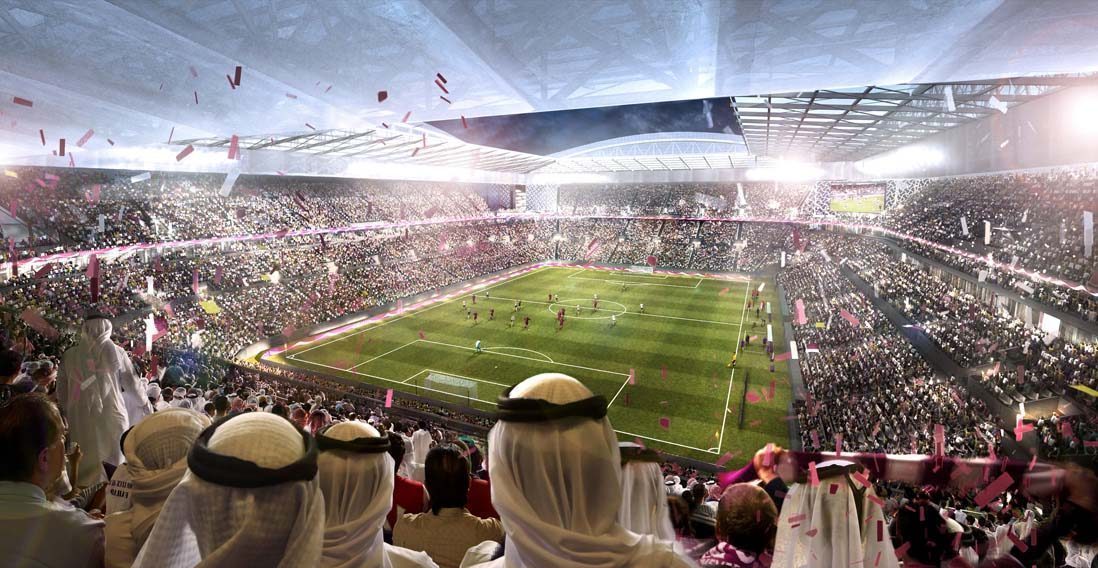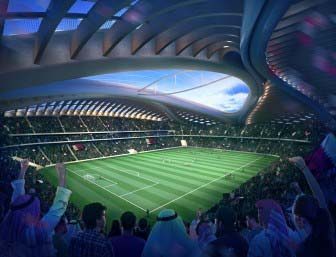
Qatar will decide the final number of stadiums it plans to build to host the World Cup in 2022 before the end of this year, a spokesman for the local organizing committee has told Reuters.
Qatar’s World Cup bid pledged to build 12 stadiums, although it now seems possible that the country may build just eight, the minimum number FIFA rules require in order to host the 64 matches played during the international tournament.
Work is already underway to build from scratch or redevelop five stadium sites, while the designs for a sixth arena at Lusail City, which will host the opening ceremony and final match, are being prepared by Foster + Partners, the firm led by British architect Sir Norman Foster.
An official from World Cup organizers the Supreme Committee for Delivery and Legacy (SCDL) also said last year that sites at Qatar Sports Club in Dafna/West Bay, and another near Hamad International Airport were also ear-marked for development as venues.
This would bring the number of stadiums sites already openly discussed to eight.
However, the unnamed spokesman for the SCDL did not confirm this number, and told Reuters that the number of venues was “still to be confirmed” and that “a decision was expected to be reached towards the end of 2015.”
The spokesman also refused to reveal the cost of the venues, at least two of which have been designed by internationally-renowned architects.
“Due to the stadiums currently going through the tender process, we are not in a position to release any further budgetary figures at this stage,” he added.
Final approval

When a final decision has been reached, Qatar will submit its proposal on the number of hosting venues to FIFA, and the football world governing body will take the final decision on the arenas that will be used.
FIFA had previously said it would rule on this earlier this year, but it has since been embroiled in allegations of corruption and its President Sepp Blatter has announced his resignation.
US and Swiss officials are now undertaking separate investigations into possible corruption in the awarding of the 2018 and 2022 World Cups to Russia and Qatar.
The venues
Designs for five of the planned venues have already been revealed.
Al Wakrah stadium, designed by AECOM and Zaha Hadid architects, was the first venue to be confirmed and it is being built from scratch in the rapidly-expanding fishing town south of Doha.

The modular, 40,000-seater stadium has been designed to resemble a dhow boat that Qataris traditionally used for pearl diving, and is slated for a 2018 completion.
Enabling works are already underway and the first concrete has been poured above ground on the site. Those bidding for the lucrative construction deal include Contracting firm BAM International in a joint venture with Qatar’s Urbacon Contracting and Trading (UCC).
The winning tenders for the site are expected to be announced later this year or in early 2016, Construction Week reports.
Meanwhile, Italian firm Salini Impregilo Group, which has a joint venture with Qatar-based Galfar Al Misnad and the Italian firm Cimolai, has signed a QR3.11 billion (€770 million) contract for the construction, operation and maintenance of the 70-000 seater Al Bayt Al Khor stadium, north of Doha.

The stadium’s design will resemble a traditional tent used by nomads around the region, and at the time of the design launch last year, the Supreme Committee said the exterior would be covered in black fabric, with the traditional red and white fabric on the interior.
It is due for completion by September 2018.
The Qatar Foundation Stadium in Education City has been designed to be a “diamond in the desert” whose geometric patterns will appear to change color as the sun arcs across the sky, according to its architect Mark Fenwick. The 40,000 capacity venue will be used for matches through to the quarter-finals of the World Cup and construction of it is expected to be complete by the end of 2018.
Khalifa International Stadium in the Aspire Zone is also being extensively remodeled and is expected to be the first venue to be complete when work wraps up next year.

It will keep its iconic metal arches, but will be reconfigured inside to create a 40,000-seater venue in a complex which will also include an Olympic and sports museum.
The main contractors on the refurbishment are a joint venture comprised of local contracting firm Midmac and a subsidiary of Belgium–headquartered Besix Group, Six Construct.
Meanwhile, Al Rayyan Stadium, which is set for a 2019 completion date, will be totally rebuilt rather than just refurbished, as was originally planned.
Designed by UK-based Ramboll and Pattern, the rectangular-shaped building was inspired by sand dunes and is slated to have soft corners and undulating waves, drawing on Islamic geometric influences that are also evident in the facade of Qatar’s iconic Burj Al Arab building in West Bay.
Cooling technology

Although the 2022 World Cup will now not be played in the summer, Qatar is continuing with plans to develop cooling technology that would enable athletes to compete even when it’s 50 degrees outside.
Last week, the Supreme Committee said it had installed a weather station at Al Wakrah stadium, with equipment monitoring meteorological data every five minutes and air quality information every 15 minutes.
Two additional weather stations will be installed at the Al Rayyan and Lusail stadium sites, and data collection and analysis of the information will be conducted for at least three years to help calibrate the cooling technology for the venues, the SCDL said.
Thoughts?







